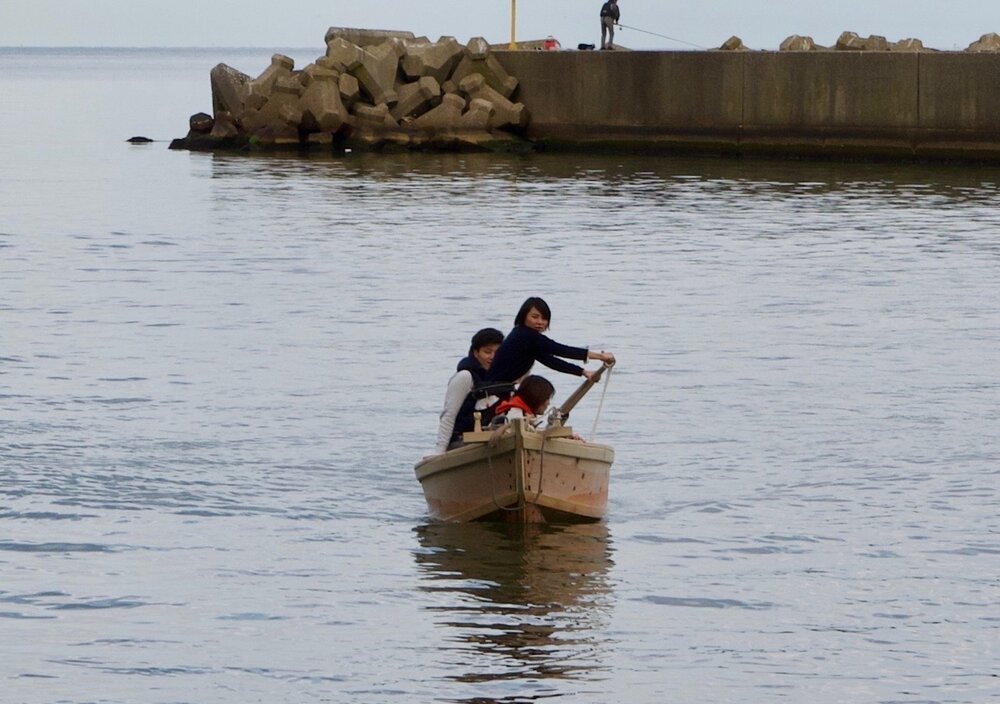Shinsuishiki
by Douglas Brooks
Shinto is the native religion of Japan, and today, it coexists with Buddhism, which arrived later from mainland Asia. The core belief in Shinto is that a kami, meaning deity or spiritual essence, pervades all things. Shinto does not practice regular, congregational, worship as Western religions do; adherents instead participate in various rituals invoking the kami to bless and purify objects, activities, and their participants.
My personal understanding of Shinto comes mainly from boat-related ceremonies I have witnessed or participated in. These are universally Shinto-based and center primarily on the twin gods of the sea and the forest. While some boatbuilders invite priests to conduct ceremonies at particular milestones, such as when the backbone of the boat is completed, most take place at launching.
The boat launching ceremony is typically called shinsuishiki (literally, "enter water ceremony") or less commonly, funeoroshi (literally, “boat ceremony”). The purpose is to ritually purify the boat, as well as its builders and owners. Salt is important for purification as is sake (rice wine). Beyond that, each launching ceremony reflects local customs and traditions. There may be as many different kinds of launching ceremonies as there are fishing villages. I have even found that elements of a launching ceremony in one village may be considered completely wrong in a village nearby.
The altar Bansho san and his wife set up for the launching with fish, fruits and vegetables, salt, and sake. Photo Credit: Douglas Brooks.
Our launching ceremony was presided over by Bansho san himself. He told us in the old days a priest would conduct launchings only for large vessels. Bansho san and his wife set up an altar in the boat with fish, vegetables, salt, and two large bottles of sake (called omiki when used ceremonially). Bansho san made sure we understood that the procedure was to bow twice to the altar, clap twice, and then bow onceagain. He did so and then invited me to do so. Strangely, he didn’t invite Nina, which was unfortunate. Instead he open a bottle of sake and walked around the boat pouring at the bow, stern and both sides of the main beam. He threw handfuls of salt fore and aft. Finally, he took a very old piece of folded paper from an envelope and began the norito, a ritual recitation of prayer. He did this in a deep, dramatic, chant-like voice. It was something I have only seen Shinto priests do.
Then, we pushed the boat into the water and participants took turns trying the sculling oar. We skipped one of the more common elements of launchings I have seen: slowly spinning the boat in the water with a paddle three times to starboard. In Tokyo, at a launching in 2003, everyone agreed this was an important part of the ceremony, but the custom was so ancient that no one knew exactly what it meant except for a vague notion that the number three was lucky. There was no mention of doing this in Himi.
Three young people from Himi give the boat a spin after the launch ceremony. Photo Credit: Douglas Brooks.
Sometimes, new boats have an alcove for ritual objects. These vary by place but a very common one is a pair of dice. One boatbuilder stressed to me that the dice had to be wrapped side-by-side so the ones faced up, the threes faced forward, the fours faced aft, and the sixes faced down. This arrangement is consistent and widespread throughout Japan, and a poem describes the practice. The verse is replete with homophones, as word play is an integral part of Japanese humor. The poem translates:
One for Heaven,
Six for Earth,
Three together for the bow,
Four together for the rudder,
Five curved for the sculling oar,
And two in a pile in the middle.
Placing the maximum number on the bottom is believed to place the “weight” lower, enhancing the stability of the boat. The word play includes “three together” (miawase), which also has a romantic meaning of “exchanged glances.” “Four together” (shiawase) is a homophone for “happiness.” “Five curved” (gossori) also means “full” as in full of fish. “Two in a pile” (ni dossari) can mean “a heap," as in a pile of fish in the bilge [1].
Most boat shops I have worked in had some reference to Shinto, whether a sprig of cedar left on the boat for New Years or a small shrine. An 82-year old craftsman in the Gokase River valley in Miyazaki Prefecture demonstrated an interesting integration of Shinto into a craftsman’s life. At one point, while we were talking about his work, he needed to cut a piece of scrap wood to demonstrate a technique. As he stepped up to his bandsaw, he paused, bowed his head, and clapped his hands twice, holding them for a moment in prayer. Then he switched on the saw and made the cut. I asked him what he had done and he told me it was his custom to “ask” the power tool to be good to him. He said he performed this the first time he used any power tool in a given month.
[1] Koji Matano transcribed the original poem from Mr. Takashi Tsuda, an eighty-four year old boatbuilder on Naoshima, Kagawa Prefecture. James Huffman, Koji Matano, and Tsugaru Ryosuke all contributed to my translation and explanation of it.


